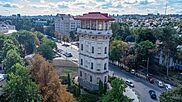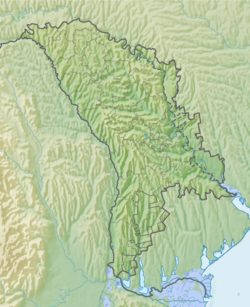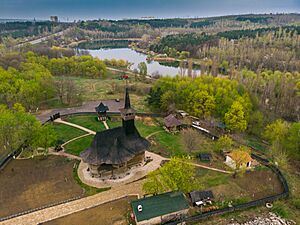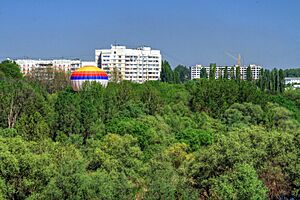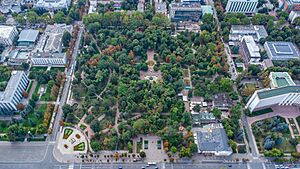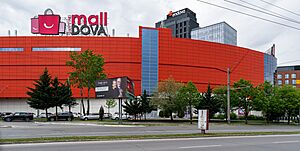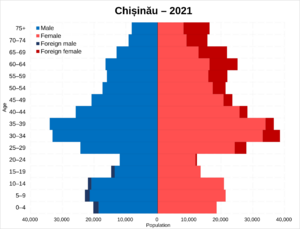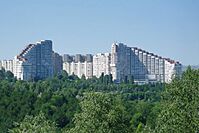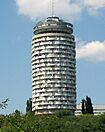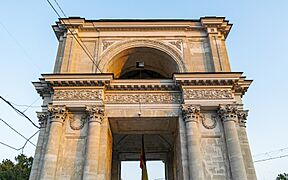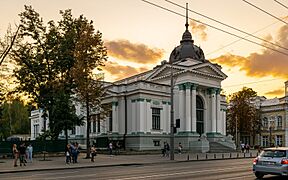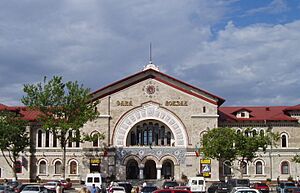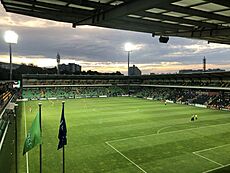Chișinău facts for kids
Quick facts for kids
Chișinău
|
|||
|---|---|---|---|
|
Chișinău City Hall
Triumphal Arch and Nativity Cathedral
Stephen the Great Monument
Chișinău Water Tower
City Gates
Mihai Eminescu National Theatre
Valea Morilor Park
|
|||
|
|||
| Nickname(s):
Orașul din piatră albă
(lit. The city of white stone) |
|||

Location of Chișinău in Moldova
|
|||
| Country | |||
| First written mention | 14 October 1436 | ||
| Government | |||
| • Type | Mayor–council government | ||
| Area | |||
| • Capital city and municipality | 123 km2 (47 sq mi) | ||
| • Metro | 571.6 km2 (217.5 sq mi) | ||
| Elevation | 85 m (279 ft) | ||
| Population
(2014 census)
|
|||
| • Capital city and municipality | 532,513 | ||
| • Estimate
(2019)
|
639,000 | ||
| • Density | 4,329/km2 (11,210/sq mi) | ||
| • Urban | 702,300 | ||
| • Rural | 77,000 | ||
| • Metro | 779,300 | ||
| GDP | |||
| • Capital city and municipality | €3.448 billion (2015) | ||
| • Per capita | €5,400 (2015) | ||
| Time zone | UTC+02:00 (EET) | ||
| • Summer (DST) | UTC+03:00 (EEST) | ||
| Postal code |
MD-20xx
|
||
| Area code(s) | +373-22 | ||
| ISO 3166 code | MD-CU | ||
| HDI (2021) | 0.835 high · 1st |
||
| a As the population of the Municipality of Chișinău (which comprises the city of Chișinău and 34 other suburban localities) | |||
Chișinău is the capital and largest city of Moldova. It's located in the middle of the country, on the Bîc River. This city is Moldova's main center for business and industry.
Chișinău is known for its long history of winemaking. Every October, the city hosts a national wine festival. Even though many buildings were damaged in World War II and by earthquakes, Chișinău still has many beautiful old buildings. These include the Chișinău City Hall and the Nativity Cathedral. The city also has important museums like the National Museum of Fine Arts.
Contents
- What Does Chișinău Mean?
- A Brief Look at Chișinău's History
- Where is Chișinău Located?
- Chișinău's Economy and Shopping
- Who Lives in Chișinău?
- Exploring Chișinău's Buildings
- Culture, Learning, and Fun in Chișinău
- Media in Chișinău
- Getting Around Chișinău
- Sports in Chișinău
- Famous People from Chișinău
- Chișinău's Sister Cities
- See also
What Does Chișinău Mean?
The name Chișinău has a few possible origins. One idea is that it comes from old Romanian words. These words mean "spring" or "source of water" and "new." This makes sense because the city was built around a small spring.
Another idea is that the name is similar to a town in Western Romania called Chișineu. This name might come from a Hungarian tribe called Jenő. Many places are named after this tribe.
A third idea suggests the name might come from an old Cuman word. This word means "grave" or "cemetery." It could also be linked to a Persian word for "house."
In the past, especially when it was part of the Russian Empire, the city was known as Kishinev in English. Today, the name Chișinău, based on the Romanian name, is used more often.
A Brief Look at Chișinău's History
Chișinău began as a village around a monastery in 1436. It was part of the Principality of Moldavia. In the early 1800s, it was a small town with about 7,000 people.
Becoming a Russian Imperial City
In 1812, after a war, the eastern part of Moldavia became part of the Russian Empire. Chișinău was made the capital of this new area, called Bessarabia.
The city grew with a new plan that created wide, long roads. Important buildings were constructed, like the Catedrala Nașterea Domnului and the Triumphal Arch. By 1900, the population had grown to over 125,000 people.
Times of Change and Conflict
In the late 1800s, many Jewish people moved to Chișinău. By 1897, nearly half of the city's population was Jewish. Sadly, there were violent events against Jewish people in 1903 and 1905. These events caused damage and loss of life.
Under Romanian Rule
After the Russian Revolution, Bessarabia became independent. It then joined the Kingdom of Romania. Chișinău became Romania's second-largest city. During this time, the city center was greatly improved. New buildings were constructed, and education programs were started. The Stephen the Great Monument was built in 1927.
World War II and Soviet Times
In 1940, Chișinău became the capital of the new Moldavian Soviet Socialist Republic. During World War II, the city suffered a lot. It was bombed and many buildings were destroyed. Many people, especially Jewish residents, faced terrible persecution.
After the war, Chișinău was rebuilt. Architects created a new city plan. Many large apartment buildings were constructed, changing the city's look. This period saw fast population growth. In 1977, another strong earthquake hit the city.
After Moldova's Independence
Moldova became independent from the Soviet Union in 1991. Since then, many streets in Chișinău have been renamed to honor historical figures and events.
Recently, Chișinău has been a place of support for Ukrainian refugees. In 2023, the city hosted a large rally supporting Moldova's goal to join the European Union. It also hosted an important international summit to discuss regional issues.
Where is Chișinău Located?
Chișinău is located on the Bâc River, which flows into the Dniester. The city itself covers about 120 square kilometers. The wider municipality, which includes nearby communities, is about 635 square kilometers.
The city is in central Moldova. It's surrounded by flat, fertile land. Chișinău is almost exactly in the middle of Moldova. It's about 58 kilometers from the Romanian border and 54 kilometers from the Ukrainian border.
What's the Weather Like?
Chișinău has a climate with warm summers and cold, windy winters. In winter, temperatures often drop below freezing. Summer temperatures usually average around 25°C, but can sometimes reach 35-40°C. Most of the rain falls during the summer, often as heavy storms.
Spring and autumn have milder temperatures, usually between 16°C and 24°C. Rain is less frequent but still occurs.
| Climate data for Chișinău (1991–2020, extremes 1886–present) | |||||||||||||
|---|---|---|---|---|---|---|---|---|---|---|---|---|---|
| Month | Jan | Feb | Mar | Apr | May | Jun | Jul | Aug | Sep | Oct | Nov | Dec | Year |
| Record high °C (°F) | 16.6 (61.9) |
20.7 (69.3) |
25.7 (78.3) |
31.6 (88.9) |
35.9 (96.6) |
37.5 (99.5) |
39.4 (102.9) |
39.2 (102.6) |
37.3 (99.1) |
32.6 (90.7) |
23.8 (74.8) |
18.3 (64.9) |
39.4 (102.9) |
| Mean daily maximum °C (°F) | 1.1 (34.0) |
3.4 (38.1) |
9.2 (48.6) |
16.4 (61.5) |
22.3 (72.1) |
26.1 (79.0) |
28.4 (83.1) |
28.3 (82.9) |
22.3 (72.1) |
15.5 (59.9) |
8.1 (46.6) |
2.7 (36.9) |
15.3 (59.5) |
| Daily mean °C (°F) | −1.8 (28.8) |
−0.2 (31.6) |
4.5 (40.1) |
11.0 (51.8) |
16.8 (62.2) |
20.7 (69.3) |
22.9 (73.2) |
22.6 (72.7) |
17.0 (62.6) |
10.8 (51.4) |
4.8 (40.6) |
−0.2 (31.6) |
10.7 (51.3) |
| Mean daily minimum °C (°F) | −4.2 (24.4) |
−3.0 (26.6) |
0.7 (33.3) |
6.3 (43.3) |
11.8 (53.2) |
15.9 (60.6) |
17.9 (64.2) |
17.5 (63.5) |
12.5 (54.5) |
7.1 (44.8) |
2.1 (35.8) |
−2.5 (27.5) |
6.8 (44.2) |
| Record low °C (°F) | −28.4 (−19.1) |
−28.9 (−20.0) |
−21.1 (−6.0) |
−6.6 (20.1) |
−1.1 (30.0) |
3.6 (38.5) |
7.8 (46.0) |
5.5 (41.9) |
−2.4 (27.7) |
−10.8 (12.6) |
−21.6 (−6.9) |
−22.4 (−8.3) |
−28.9 (−20.0) |
| Average precipitation mm (inches) | 36 (1.4) |
31 (1.2) |
35 (1.4) |
39 (1.5) |
54 (2.1) |
65 (2.6) |
67 (2.6) |
49 (1.9) |
48 (1.9) |
47 (1.9) |
43 (1.7) |
41 (1.6) |
555 (21.8) |
| Average extreme snow depth cm (inches) | 7 (2.8) |
6 (2.4) |
3 (1.2) |
0 (0) |
0 (0) |
0 (0) |
0 (0) |
0 (0) |
0 (0) |
0 (0) |
1 (0.4) |
3 (1.2) |
7 (2.8) |
| Average rainy days | 8 | 7 | 11 | 13 | 14 | 14 | 12 | 10 | 10 | 11 | 12 | 10 | 132 |
| Average snowy days | 13 | 13 | 8 | 0 | 0 | 0 | 0 | 0 | 0 | 0 | 6 | 11 | 51 |
| Average relative humidity (%) | 82 | 78 | 71 | 63 | 60 | 63 | 62 | 60 | 66 | 73 | 81 | 83 | 70 |
| Mean monthly sunshine hours | 70 | 96 | 155 | 210 | 283 | 301 | 326 | 308 | 220 | 162 | 81 | 65 | 2,277 |
| Source 1: Pogoda.ru.net | |||||||||||||
| Source 2: NOAA (sun, 1991–2020) | |||||||||||||
Chișinău's Economy and Shopping
Chișinău is the financial and business heart of Moldova. It produces about 60% of the country's economy. The city has a large and growing media industry. Many national and international banks have their main offices here.
You can find many modern shopping centers in Chișinău. These include MallDova and Port Mall. There are also well-known stores like N1, Linella, and Kaufland. While some people still prefer traditional markets, many enjoy shopping at these newer places.
The city also has several amusement parks. One is in the Botanica district, near three lakes. Another, Aventura Park, is more modern.
Who Lives in Chișinău?
| City of Chișinău | ||||||||||||||||||||||||||||||||||||||||||||||||||||||||||||||
|---|---|---|---|---|---|---|---|---|---|---|---|---|---|---|---|---|---|---|---|---|---|---|---|---|---|---|---|---|---|---|---|---|---|---|---|---|---|---|---|---|---|---|---|---|---|---|---|---|---|---|---|---|---|---|---|---|---|---|---|---|---|---|
|
|
|
||||||||||||||||||||||||||||||||||||||||||||||||||||||||||||
| c-census; e-estimate | ||||||||||||||||||||||||||||||||||||||||||||||||||||||||||||||
| Municipality of Chișinău | |||||||||||||||||||||||||||||||
|---|---|---|---|---|---|---|---|---|---|---|---|---|---|---|---|---|---|---|---|---|---|---|---|---|---|---|---|---|---|---|---|
|
|
||||||||||||||||||||||||||||||
| c-census; e-estimate; Source: | |||||||||||||||||||||||||||||||
In 2014, about 532,513 people lived in Chișinău. The larger area, including nearby towns, had about 700,000 people. The population has changed over time, with growth in some periods and decreases in others.
What Languages are Spoken?
The main languages spoken in Chișinău are Romanian and Russian. Many people speak both. The term "Moldovan" is also used for the Romanian language spoken in Moldova.
What are the Main Religions?
Most people in Chișinău are Christians. The largest group is Orthodox Christians. There are also smaller communities of Protestants and Roman Catholics. The city has many churches and synagogues.
Exploring Chișinău's Buildings
Chișinău's city plan was created in the 1800s. Many beautiful Orthodox churches and 19th-century buildings can be seen. Examples include Ciuflea Monastery and the Transfiguration Church. Much of the city is built from limestone, which is a white stone. This is why Chișinău is sometimes called "The city of white stone."
Since 1991, many modern buildings have been added. These include new offices and shopping centers. However, you can still see many older Soviet-style apartment blocks throughout the city.
Culture, Learning, and Fun in Chișinău
Learning and Museums
Chișinău is a big center for education. It has many public and private universities. The Academy of Sciences of Moldova is also located here. Some of the main universities include Moldova State University and the Academy of Economic Studies of Moldova.
In 2022, the first Christian university in Moldova opened in Chișinău. It works with an American university.
The city is home to several important museums:
- The National Museum of Ethnography and Natural History is the oldest museum in Moldova. It has over 135,000 items, including exhibits on nature, history, and culture.
- The National Museum of Fine Arts showcases art.
- The National Museum of History of Moldova tells the story of the country.
The National Library of Moldova is also in Chișinău.
Events and Festivals
Chișinău celebrates its culture with various events. The "Moldova National Wine Day" and "Wine Festival" happen every year in early October. These festivals celebrate the grape harvest and Moldova's long history of making wine. The streets fill with people enjoying food, wine, music, and dance. Moldova is known for its excellent wines, especially from smaller, family-run wineries.
Media in Chișinău
Most of Moldova's media companies are based in Chișinău. There are many radio stations and TV channels broadcasting in the city. The first radio station, Radio Basarabia, started in 1939. The first TV station, Moldova 1, began in 1958.
Moldova 1 is the national public broadcaster. Other TV channels include Pro TV Chișinău and PRIME. Many radio stations also have their headquarters here, like Vocea Basarabiei and BBC Moldova.
Getting Around Chișinău
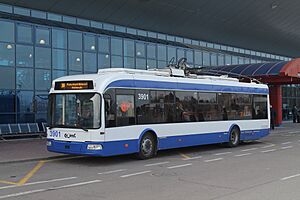
Airport
Chișinău International Airport connects the city to many places in Europe and Asia. Several airlines have their main offices or hubs at this airport.
Road Travel
Buses are a very popular way to travel in and out of Chișinău. The city has three main bus terminals. You can take buses to other cities in Moldova, and to places like Odesa in Ukraine or Bucharest in Romania.
Train Travel
Trains are another important way to travel within Moldova. The main train station is Chișinău Central Railway Station. You can take international trains from here to cities like Bucharest, Kyiv, and Moscow.
Public Transport in the City
Trolleybuses
Chișinău has a large network of trolleybuses. These electric buses are a common way to get around. There are 22 trolleybus lines, covering about 246 kilometers. They run from early morning until late at night. A trolleybus ticket is very affordable.
Buses
There are also 29 bus lines within Chișinău. Each bus stop has a schedule for both buses and trolleybuses.
Minibuses
Privately run minibuses, called "rutieras", are also common. They follow the main bus and trolleybus routes and are often seen more frequently. Minibus tickets cost the same as bus tickets.
Traffic in the City
Traffic in Chișinău is becoming more crowded each year. There are about 300,000 cars in the city daily, plus many transit vehicles. The number of cars is expected to grow even more in the future.
Sports in Chișinău
Football is the most popular sport in Chișinău. Local teams like Zimbru and Dacia Buiucani play in Moldova's top football league.
Zimbru Stadium is a modern football stadium that opened in 2006. It can hold 10,500 fans and is the home stadium for the Moldova national football team.
Chișinău also has an indoor arena called Arena Chișinău, which opened in 2022. There's also a beach soccer stadium, the FMF Beach Soccer Arena, which has hosted international events. The city also holds an annual Chișinău International Marathon.
Famous People from Chișinău
Many notable people have come from or lived in Chișinău. Here are a few:
- Olga Bancic – a hero in the French Resistance during World War II.
- Maria Cebotari – a famous Romanian opera singer and actress.
- William F. Friedman – an important American expert in codes and secret messages.
- Avigdor Lieberman – an Israeli politician.
- Lewis Milestone – a well-known American movie director.
- Andrew Rayel – a Moldovan DJ.
- Sergey Spivak – a Moldovan UFC fighter.
- Dan Balan – a musician, singer, and songwriter.
- Eugen Doga – a famous composer.
- Pasha Parfeny – a singer who represented Moldova in the Eurovision Song Contest.
- SunStroke Project – a music group that represented Moldova in the Eurovision Song Contest.
Chișinău's Sister Cities
Chișinău has many sister cities around the world. These partnerships help build friendships and cultural exchange between cities. Some of Chișinău's sister cities include:
- Alba Iulia, Romania
- Ankara, Turkey
- Bucharest, Romania
- Grenoble, France
- Kyiv, Ukraine
- Mannheim, Germany
- Odesa, Ukraine
- Sacramento, United States
- Tbilisi, Georgia
- Tel Aviv, Israel
- Yerevan, Armenia
- Kingston Upon Hull, England
See also
 In Spanish: Chisináu para niños
In Spanish: Chisináu para niños





